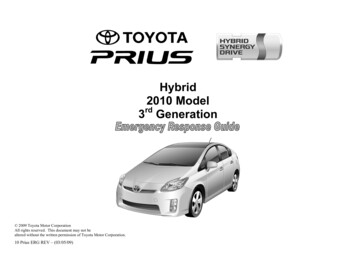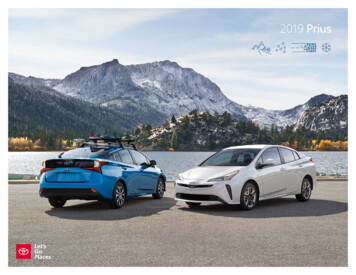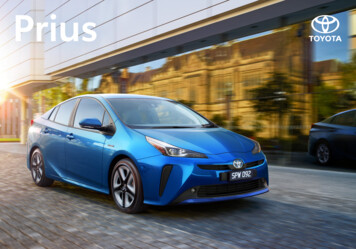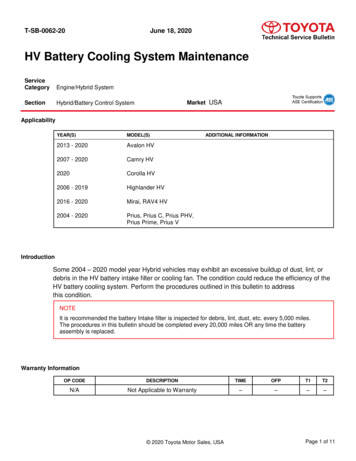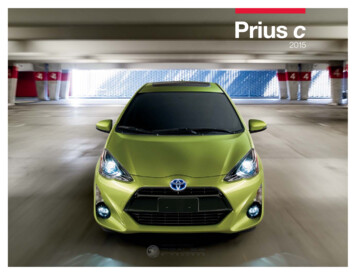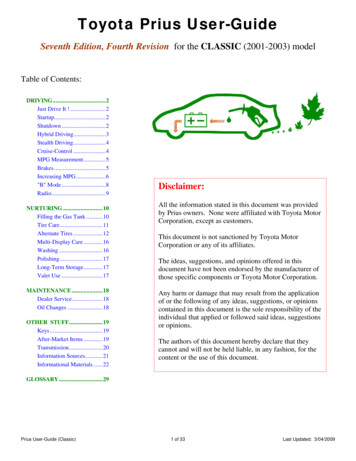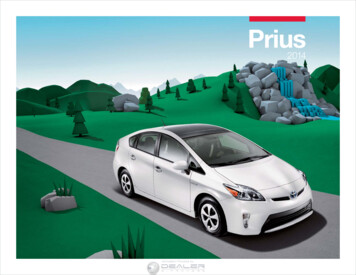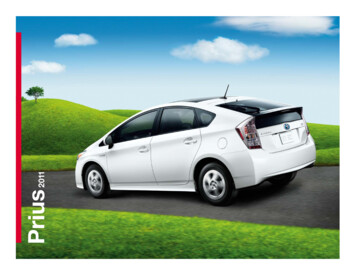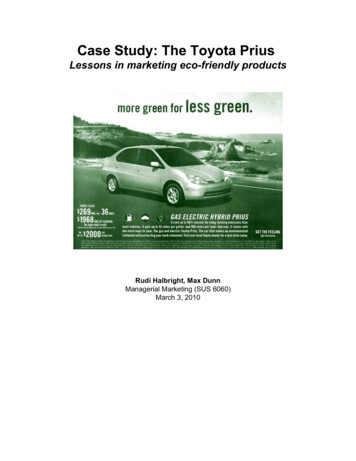
Transcription
Case Study: The Toyota PriusLessons in marketing eco-friendly productsRudi Halbright, Max DunnManagerial Marketing (SUS 6060)March 3, 2010
Introduction“If you owned [a hybrid car], you could feel good about using less gasoline and being atrendsetter, but you couldn't expect the fuel savings to make up for the thousands ofextra dollars that the hybrid cost. There was no financial reward for environmentalvirtue.” (Leonhardt, 2006)This quote neatly presents the tradeoffs in marketing a green product like hybrid cars; often theyare not competitive by themselves in terms of prices or features. So how do you market a productlike this? Can you convince a lot of people to forgo features or pay more money in order to beeco-friendly?In general, the answer is no. While certain market segments will show a preference for ecofriendly products, those attributes alone are not enough for a product to gain widespreadacceptance (Power, 2008). The Toyota Prius provides a concrete case study of this truth. Whilethe biggest product differentiation of the Prius is a fuel efficient, hybrid engine, most peopledon't buy it because it is eco-friendly.ThesisWe assert that Toyota succeeded by marketing the Prius on multiple factors including thepotential for gas savings, appeal to those who desire the latest technology, crossing into multiplemarket segments, and keeping the car practical, attractive, and functional. If they had appealedsolely on impact to the environment, they would have failed to generate significant marketpenetration.BackgroundToyota didn't set out to create a hybrid car. Rather, then Chairman Eiji Toyoda was concernedabout the increasing popularity of larger cars and of the effect it would have on pollution levelsin increasingly congested cities. He was concerned about the threat of peak oil looming andbelieved that the traditional internal combustion engine would not successfully carry Toyota intothe next century. It was a year into that effort that Toyota decided to adapt a hybrid approach tocreating a car with a lower impact on the environment. Toyota was cautious in entering theAmerican market (Itazaki, 1999).Initial TrialToyota's first step was to ship the original Prius that had been sold in the Japanese marketbeginning in 1997 to the U.S.
These Prius' were right hand driving models asno left hand models had yet been produced. Thecar was shown to potential customers inSouthern California who complained that theinterior seemed cheap, the rear seats couldn'tfold down, and it wasn't even possible to fit ababy stroller in the trunk (Taylor, 2006).Toyota quickly learned that their first Prius wasa poor fit for the U.S. market.First generation Prius NHW10(Source: http://wikicars.org/en/Toyota Prius)2000 Marketing CampaignThe first generation Prius for the U.S. market was released in 2000 with increased power to boththe internal combustion engine and electric motor. This new Prius met California emissionsstandards and included a lighter battery pack. U.S. consumers still found it to be underpoweredand burdened with other limitations including rear seats that did not fold down (Taylor, 2006).Toyota hired Saatchi and Saatchi LA and OasisAdvertising of New York to help them advertiseand position the new Prius. Working with thesefirms, Toyota realized that they needed tocommunicate not only the Prius' environmentaladvantages but also communicate how desirableand practical it was for regular, everydaytransportation. The "PRIUS/genius" campaignlaunced as the result of this combined effort.(Geller, 2000).(Source: http://john1701a.com/prius/scans/Prius-Ad 19.jpg)Starting two years before the Prius was availablein the US, the campaign began by creating adialogue with customers that resulted in 40,000people expressing an interest in the Prius. Theseprospects were given early access to a privateweb site and were able to pre-order the Prius,which 1,800 did. (Geller, 2000). The campaignthen continued onto a more traditional formusing broadcast and print advertising andcontinued to combine interactive, outdoor andlifestyle marketing (Geller, 2000).
Toyota also worked with MindArrow systems to replace printed brochures with interactive,multimedia "eBrochures". This was very successful as 46% of the people that viewed theeBrochure clicked through to the Prius site and 36% requested additional information (Geller,2000).While we are used to social media marketing today, Toyota was ahead of it's time in usingit back in 2000, and it's not surprising, that they succeeded in attracting innovators and someearly adopters.Surprisingly, Toyota found out that the more extremeenvironmentalists were not interested in the Prius or otherhybrids. They were frugal and turned off by the high techaspects of the cars (Taylor, 2006).However, this early Prius did not stack up based on eitherfeatures or price compared to its competitors and themarketing campaign heavily emphasized the car's greenaspects. Toyota had only succeeded in selling to anaudience of innovators and a limited number of earlyadopters who were drawn to the technology and willing totake a risk.(Source: http://lotusracer.home.mchsi.com/priuscard.jpg)As a result these initial marketing efforts failed in their attempts to produce mass appeal and only15,000 cars were sold in 2001 and approximately 20,000 were sold in 2002 (Vasilash, 2004).Crossing "the Chasm" (see Technology Adoption Lifecycle below) was going to require furtherinnovation and a different marketing strategy.(Source: http://www.designitsimple.de/)
2004 CampaignIt wasn't until the next the nextgeneration Prius debuted in late2003 for the 2004 model year thatbegan to take off. The new Priuswas larger, had a more efficientdrivetrain yielding improvedmileage, and finally responded toearlier demands for a large cargoarea with rear seats that foldeddown. Toyota had listened to itscustomers and met and exceededtheir expectations. (See Appendixfor SWOT analysis.)(Source: http://www.siliconeer.com/past issues/2004/JULY2004FILES/july04 prius 1.jpg)The marketing campaign focused on the new Prius's larger size and higher power and deemphasized the fact that it also happened to be environmentally friendly (Rodriguez & Page,2004)During this time, the Honda Civic Hybrid actually had higher sales than the Toyota Prius.Instead of focusing on technophiles and early adopters, Honda introduced the Civic Hybriddirectly to the mass market by taking advantage of Civic's existing brand equity and marketing itas having the added benefit of increased gas mileage (Rodriquez, 2004).Beginning in 2007 the Toyota Prius outsold all other hybrids. One reason for this increase issales is that it had became "cool" to drive a hybrid. While the other hybrids looked just likedtheir non-hybrid counterparts, the Prius was easily recognizable due to it's unique body designand distinct identity. When Prius buyers were surveyed in 2007 regarding why they bought aPrius, more than half said it was because it made a statement about them. Three years previously,only one-third had cited that reason. "I felt like the Camry Hybrid was too subtle for the messageI wanted to put out there," said one Prius owner. "I wanted to have the biggest impact that Icould, and the Prius puts out a clearer message." Another said "I really want people to know thatI care about the environment." This cachet of Prius ownership was reinforced by the manycelebrities and Hollywood stars that embraced the Prius (Maynard, 2007).The turning point for the Prius was triggered by it now being feature competitive with similarcars and by the new marketing campaign that shifted from a focus on early adopters andenvironmental friendliness to the mass market and economic benefits (Wigder, 2007). "TheChasm" had been crossed and the Prius was in high demand. In a 2007 survey was published thatreaffirmed Toyota's new marketing strategy. It had found that 73% of Prius owners acted likemass market consumers and that the Prius appealed to high-income buyers (Klein, 2007).
Segment% of SampleEarly Adopters27%Prius Cost Less40%Buyers Calculated ROI Differently16%Buyer Bought Prius to Drive in Carpool Lane 12%Buy Bought Prius as Inexpensive Fun Car5%Total100%(Source: Klein, 2007)This was also confirmed by another study by J.D. Power in 2008 that found while many peopleexpressed a desire to buy an eco-friendly car, only 11% of them were "very willing" to pay morefor it (J.D. Power, 2008).2010 CampaignIn 2010, Toyota launched their new ad campaign entitled "Harmony Between Man, Nature andMachine." It emphasizes that there are no longer any tradeoffs between getting the features theywant in a car, and getting high mileage to reduce CO2 and save the planet (Hodges, 2009).(Source: http://www.toyota.com/prius-hybrid/)This campaign aims to reach a wider mass audience than previous campaigns and includes alarger role for social media including Facebook and Twitter. The sales goal for 2010 is 180,000units, up from 150,000 in 2009 (Bell, 2009), and a huge leap from the scant 15,000 that weresold in 2001.
AnalysisThe Toyota Prius holds 50% of the market for hybrid vehicles in the United States. That meansthat the combination of all other hybrid vehicles including the Camry, Civic, Escape, Highlanderand Insight, together just match the sales of the Prius, and Toyota owns well more than half ofthe total Hybrid market.Why has the Prius outperformed all other hybrid vehicles?It stands out that a significant majority of buyers surveyed felt that the Prius was less expensivethan alternatives. In fact these respondents were more likely to purchase a BMW, Mercedes orother luxury car if they didn't purchase a Prius. A full 71% of the respondents stated that the factthat Prius was only available as a hybrid was either important or a very important part of theirdecision process (Klein, 2007).Toyota used penetration pricing strategy in order to build market share rather than skim pricingstrategy of setting the price high initially and then dropping it as competitors entered. This waseffective in gaining and holding onto market share (Gutsa, 2009).In every other case, buyers have to make a choice between a less expensive standard engine vs. amore expensive hybrid model, and each looks virtually identical. In fact, in some cases (e.g. theHonda Civic Hybrid) the storage space is significantly less than the non-hybrid version, causingthe buyer to confront an obvious sacrifice.The Prius Creates High Customer Value: Saves on fuel costSaves time spent filling up with gasGenerates Peer to Peer Buzz -- as it is immediately recognizableToyota's Reputation for excellent reliabilityProvides public (environmental) benefits without requiring a sacrifice
U.S. hybrid market historical sales (1999 - 2009)(Berman, 2010)InsightsAn insight from this case study is that you can't design an inferior product and expect to make upfor it by being eco-friendly. Another is that while marketing to eco-friendly and early-adoptersegments can produce some traction, sales won't really take off until there is a compellingmessage for the mass market. The Prius has also shown that by meeting a wide enough set ofcustomers needs creating a broad appeal, coupled with strong branding, it is possible to crossover and successfully sell a product in multiple market segments.RecommendationsWhen developing a green product, make sure that it is feature competitive even without its greenaspects. Then when marketing the product, realize that most sales will be made regardless of itseco-friendliness. However, if you can establish some cachet around the product, people may buy
it as a luxury good for the environmental status it conveys, as long as the product is distinct andhighly recognizable.ReferencesBell, L. (May 15, 2009). New Toyota Prius pushlooks to reach masses. DMNews. Retrievedfrom o-reach-masses/article/136938/Berman, B. (Jan. 20, 2010). December 2009 Dashboard: Year-End Tally. HybridCars.com.Retrieved from ecember-2009-dashboard.htmlGeller, M. (Sep. 1, 2000). ANATOMY OF A BUY - Hybrid Campaign for a Hybrid Car.MediaPost Magazines. Retrieved from http://www.mediapost.com/publications/index.cfm?fa Articles.showArticle&art aid 8882Gutsa, NH. (Jun. 8, 2009) Marketing Mix in Action. Associated Content. Retrievedfrom arketing mix in actiontoyota prius.htmlHodges, A. (May 18, 2009) Toyota Prius Hybrid Launches 2010 Marketing Campaign. Retrievedfrom 11914.htmlItazaki, H. (2009). The Prius That Shook the World. Nikkan Kogyo Shimbun Ltd.Klein, J. (2007) Why People Really Buy Hybrids. Topline Strategy Group. Retrievedfrom http://www.toplinestrategy.com/Topline Strategy Report Why People Really Buy Hybrids.pdfJ.D. Power. (Mar. 6, 2008). While Many New-Vehicle Buyers Express Concern for theEnvironment, Few are Willing to Pay More for An Environmentally Friendly Vehicle. J.D.Power and Associates Reports. Retrieved from e.aspx?ID 2008029Leonhardt, D. (Jun. 21, 2006). U.S. Hybrids Get More Miles Per Congress. The New YorkTimes. Retrieved from ardt.htmlMaynard, M. (Jul. 4, 2007). Toyota's hybrid car more than a mixed success. The New YorkTimes. Retrieved from siness/04ihthybrid.4.6491389.html? r 2Rodriguez, A. & Page, C. (September 2004). A Comparison of Toyota and Honda HybridVehicle Marketing Strategies. Rocky Mountain Institute. Retrieved from
%20marketing%20strategies.pdfTaylor, A. (Feb. 21, 2006). The Birth of the Toyota Prius. Fortune Magazine . Retrieved /mostadmired fortune toyota/index.htmVasilash, G.S. (2004). The Toyota Prius: The Most Important '04 Model? Yes. AutomotiveDesign and Production. Retrieved from Wigder, D. (Apr. 29, 2007). Hybrids Shift into the Mass Market. Futurelab. Retrieved egy-innovation/2007/04/hybrids shift into the mass ma.htmlAppendixPrius SWOT AnalysisStrengths: Best fuel efficiency of any midsize car Spacious interior Good performance compared to non-hybrid vehicles Comfortable Quiet at all speeds Smoother transmission than most other cars Appeal of latest technology Minimal impact on environment Excellent scoring on crash testsWeaknesses: Fuel economy varies and optimization requires careful driving Premium price compared to similar non-hybrid cars Other cars are available in the same price range with significantly higher performance Requires use (albeit lessened) of a non-renewable resource (petroleum) Requires more energy to build than comparable non-hybrid carsOpportunities: It is likely that petroleum will cost more in the future as supplies diminish which mayincrease demand. New 2011 PHEV (Plug-in Hybrid Electric Vehicle) will extend electric mode range andimprove fuel efficiency Awareness of environmental concerns is growing Sales are likely spread to new markets in developing countries over time.
Threats: High mileage clean diesel based cars are becoming more available and will grab marketshare. Battery Electric Vehicles are fundamentally "greener" and cheaper to operate than thePrius and other hybrids Other hybrids such as the Chevy Volt will soon enter the market Toyota's recent negative press and widespread recalls are likely to scare some buyersaway. It isn't clear how severe and long-lasting the impact will be to Toyota
acceptance (Power, 2008). The Toyota Prius provides a concrete case study of this truth. While the biggest product differentiation of the Prius is a fuel efficient, hybrid engine, most people don't buy it because it is eco-friendly. Thesis We assert that Toyota succeeded by marketing the Prius on multiple factors including the


